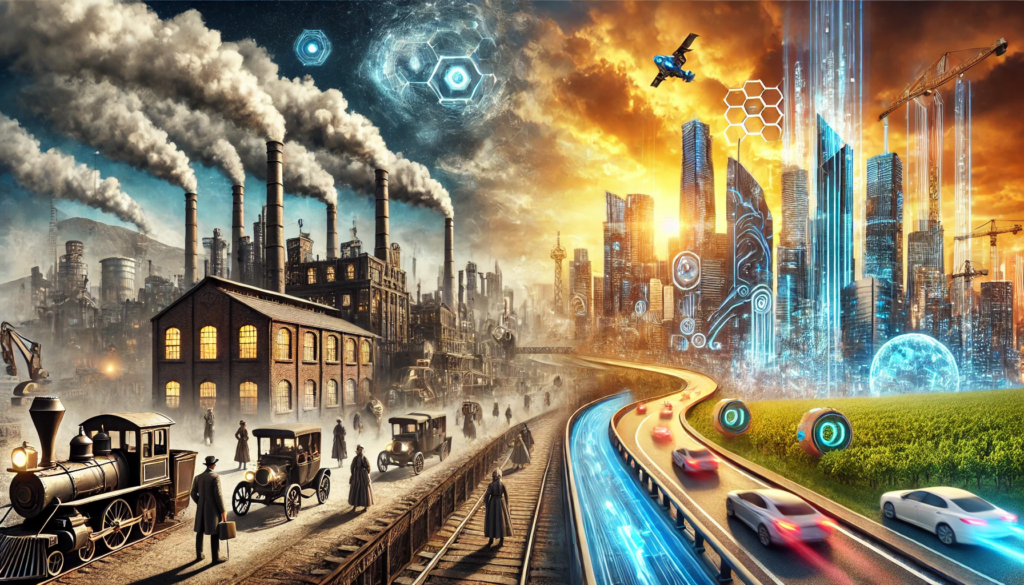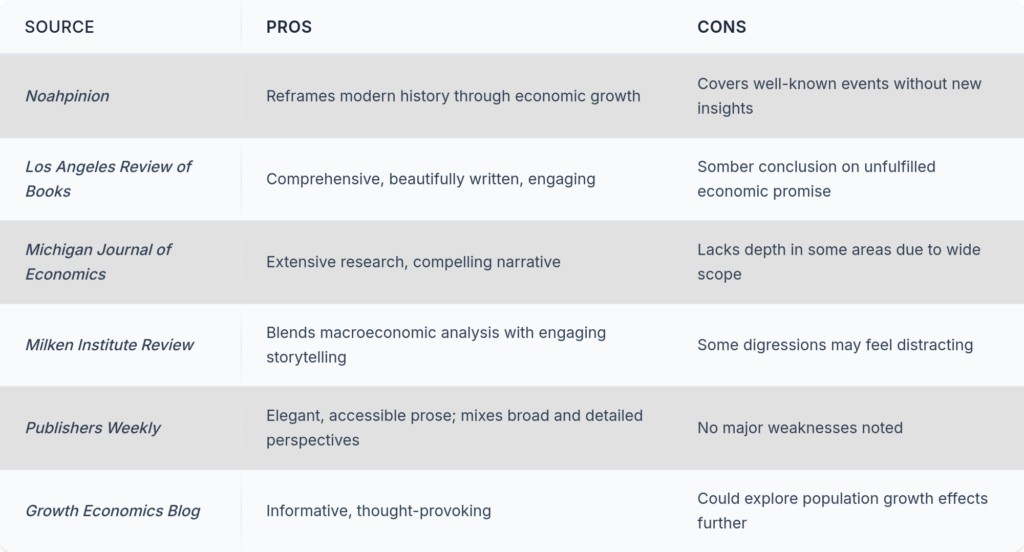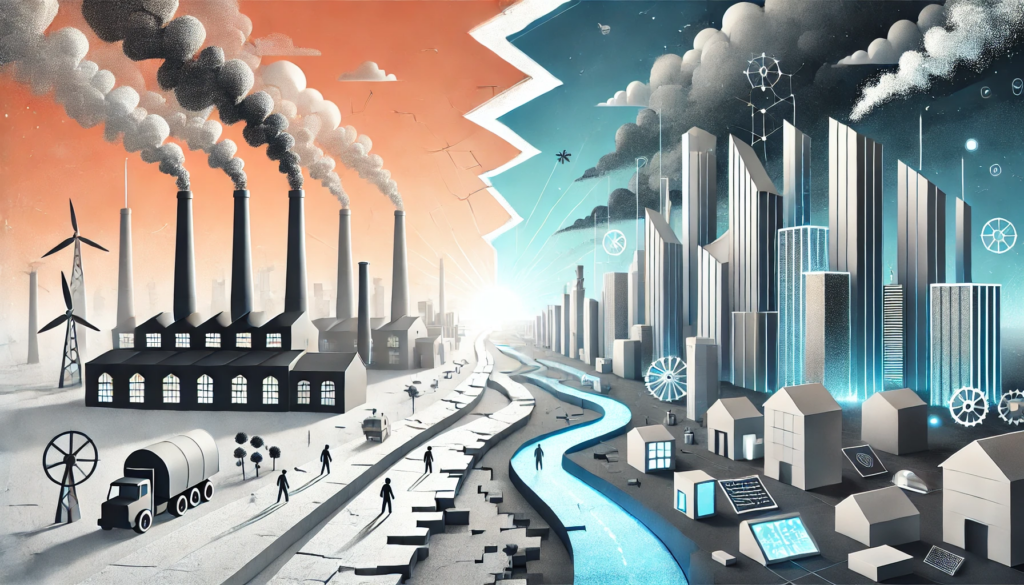
ChatGPT:
J. Bradford DeLong’s Slouching Towards Utopia is a sweeping analysis of the economic and technological transformations that shaped the world from 1870 to 2010. DeLong argues that this period—what he calls the “long twentieth century”—was unique in human history, characterized by an unprecedented acceleration of economic growth and innovation. Yet, despite remarkable progress, the world did not reach a utopia. Inequality, crises, and political struggles remained deeply embedded in society, preventing the full realization of economic potential for all.
🌍 The Economic and Historical Context
The Pre-1870 World: Slow and Uneven Growth
For most of human history, economic growth was extremely slow, and living standards changed little from generation to generation. The world was predominantly agrarian, and industrialization had only just begun to take root in the late 18th and early 19th centuries. However, DeLong argues that 1870 marked a turning point, when the combination of industrialization, globalization, and scientific progress set the stage for sustained, rapid growth.
1870 as the Inflection Point
DeLong identifies three major drivers of economic acceleration after 1870:
1. Industrialization and Technological Progress: The harnessing of fossil fuels, particularly coal and later oil, enabled new manufacturing processes, transportation networks, and communication systems.
2. Globalization: International trade expanded rapidly, creating interconnected markets and accelerating the diffusion of technology and ideas.
3. Organizational and Political Shifts: The rise of corporate structures, banking systems, and modern governance allowed for more efficient allocation of resources.
This combination led to a level of economic progress never seen before. However, this growth also created new challenges, including inequality, labor exploitation, and economic volatility.
📈 The Economic Transformations of the 20th Century
The Boom-Bust Cycles of Capitalism
While the rapid expansion of industry and commerce created enormous wealth, it also led to economic instability. The early 20th century was marked by cycles of booms and busts, culminating in the catastrophic Great Depression (1929-1939). DeLong highlights how unchecked capitalism led to speculative excesses and financial collapses, demonstrating the limits of free markets.
The Rise of Government Intervention
In response to the Great Depression, economic policies shifted dramatically:
• John Maynard Keynes’s Theories: Keynes argued that government spending was necessary to stabilize markets and maintain demand during downturns.
• The New Deal and Welfare States: Governments introduced social safety nets, regulations, and employment programs to reduce economic suffering.
These interventions laid the foundation for a more stable post-war economy.
The Golden Age of Growth (1945–1970s)
Following World War II, the world experienced an economic boom:
• Reconstruction and Industrial Expansion: The U.S. led the effort to rebuild Europe and Japan, creating robust global demand.
• Social Democracy and Middle-Class Growth: Many Western countries implemented policies that supported labor unions, expanded education, and built welfare states.
• Technological Advances: Mass production, household appliances, television, and early computing transformed daily life and productivity.
This era saw a relatively fair distribution of economic gains, with rising wages and a growing middle class. However, it was not without its flaws. Many developing nations were left out, and racial and gender inequalities persisted.
The Neoliberal Shift (1980s–2008)
The stability of the post-war economy began to unravel in the 1970s due to stagflation (high inflation and unemployment). This led to a shift towards neoliberal economic policies, including:
• Deregulation: Governments reduced their role in the economy, allowing financial markets more freedom.
• Privatization: State-owned enterprises were sold to private investors, often reducing public services.
• Globalization and Outsourcing: Companies moved production to lower-cost countries, increasing profits but reducing industrial jobs in wealthier nations.
While these changes led to significant economic growth, they also increased inequality and made economies more vulnerable to financial crises, culminating in the 2008 financial collapse.
The Digital Revolution and Its Discontents (1990s–2010s)
The rise of computers, the internet, and automation transformed the economy once again. Productivity surged, but wealth became more concentrated among those who controlled digital platforms and intellectual property. The transition to an information economy exacerbated wage disparities and left many workers behind.
⚖️ The Persistence of Inequality
Despite unprecedented wealth creation, economic inequality remained a defining feature of the 20th century. DeLong highlights several key factors:
• Wealth Concentration: The richest individuals and corporations captured a disproportionate share of economic gains.
• Labor Market Shifts: Traditional manufacturing jobs declined, replaced by precarious service and gig-economy roles.
• Racial and Gender Disparities: Women and minorities faced systemic barriers to wealth accumulation and career advancement.
Even in the most prosperous periods, economic benefits were not evenly distributed. The failure to address these disparities contributed to political unrest and economic instability.
🏛️ The Role of Government and Institutions
DeLong emphasizes that economic progress is not automatic—it requires strong institutions to ensure fair distribution and stability. He critiques the tendency of some policymakers to assume that markets will self-regulate. Instead, he argues that governments must actively:
• Provide public goods (education, healthcare, infrastructure).
• Regulate financial markets to prevent crises.
• Support workers through fair labor laws and wages.
The failure to maintain these policies in recent decades has led to stagnation for many workers, despite continued technological advancement.
🛤️ Why Haven’t We Reached Utopia?
DeLong’s central argument is that while the 20th century saw miraculous economic growth, it did not lead to an equitable or stable utopia. The reasons include:
1. Market Failures: Unregulated capitalism leads to crises, recessions, and inequality.
2. Political Constraints: Economic policies are shaped by those in power, often favoring elites.
3. Technological Disruptions: While innovation creates new wealth, it also displaces workers and industries.
4. Globalization’s Uneven Benefits: Some regions prospered while others remained underdeveloped.
5. Short-Term Thinking: Governments and corporations prioritize immediate gains over long-term stability.
🔮 Lessons for the 21st Century
DeLong concludes by reflecting on what history teaches us about the future. While capitalism and technological progress have driven enormous improvements in human well-being, they require active governance to prevent their excesses. Future challenges—climate change, automation, and rising inequality—will require strong institutional responses to avoid repeating past mistakes.
The world has slouched towards utopia, but the journey remains unfinished.
************
The concept of utopia refers to an ideal society where everything functions perfectly, often characterized by equality, harmony, prosperity, and justice. The term was first coined by Thomas More in his 1516 book Utopia, which described an imaginary island society with seemingly perfect social, political, and economic structures. Over time, different thinkers and movements have developed their own interpretations of what a utopian society might look like.
🌍 Core Characteristics of Utopia
- Economic Equality and Prosperity
• Resources are distributed fairly, eliminating poverty and extreme wealth disparities.
• Some utopias envision a moneyless society where needs are met based on cooperation rather than competition. - Social Harmony and Justice
• There is no discrimination based on race, gender, or class.
• Laws are fair, transparent, and designed to maximize well-being. - Efficient and Fair Governance
• A utopian government is often depicted as either a direct democracy, benevolent rule, or a council of wise leaders.
• Corruption and power struggles are absent, and policies are designed for the common good. - Technological and Scientific Advancement
• Technology serves humanity, eliminating dangerous or menial labor while improving quality of life.
• Medical advancements ensure long, healthy lives for all. - Environmental Sustainability
• A utopia maintains a balance with nature, avoiding pollution and resource depletion.
• Clean energy and ecological harmony are priorities. - Universal Education and Knowledge
• All citizens have access to education, fostering critical thinking and creativity.
• Science, philosophy, and the arts thrive in an intellectually open society. - No Crime or Violence
• Some utopian visions suggest that without poverty or injustice, crime would disappear.
• Conflicts are resolved through rational dialogue, not force. - Individual Freedom and Fulfillment
• People pursue careers and lifestyles based on passion rather than necessity.
• Personal relationships and community bonds are strong, leading to meaningful lives.
🏛️ Famous Utopian Models
- Plato’s Republic (c. 375 BCE)
• A society ruled by philosopher-kings, with a strict class system based on merit.
• Justice is achieved when each class performs its ideal role. - Thomas More’s Utopia (1516)
• A fictional island where private property does not exist, and people work for the collective good.
• Education, healthcare, and democracy ensure fairness. - Marxist Communism (19th Century)
• A classless, stateless society where workers collectively own the means of production.
• Exploitation and poverty are eliminated through shared resources. - Technological Utopianism (20th-21st Century)
• Advanced AI, automation, and renewable energy create a post-scarcity economy.
• Some believe space colonization could be a path to utopia. - Anarchist Utopias
• Societies with no centralized government, where people self-govern through voluntary cooperation.
• Often envisioned as peaceful, small-scale communities.
🔍 Why Hasn’t Utopia Been Achieved?
Despite various attempts to create utopian societies, obstacles remain:
1. Human Nature – Self-interest, greed, and conflict make total harmony difficult.
2. Resource Scarcity – Unequal access to land, energy, and materials creates economic divides.
3. Political Corruption – Power structures often become exploitative.
4. Technological Risks – Innovations can be misused, creating dystopian instead of utopian outcomes.
5. Cultural and Ideological Differences – One person’s utopia may be another’s nightmare, leading to disagreement over what a perfect society looks like.
🔮 Can Utopia Ever Be Achieved?
Some argue that utopia is an ideal to strive for rather than a destination. While a perfect world may be unattainable, societies can work towards better governance, economic justice, and technological progress to create a more just and prosperous future.
FAQs: Slouching Towards Utopia by J. Bradford DeLong
- What is the main argument of Slouching Towards Utopia?
J. Bradford DeLong argues that the period from 1870 to 2010 saw an unprecedented acceleration in economic growth, largely due to industrialization, globalization, and technological advancements. However, despite these gains, inequality, economic crises, and political failures prevented society from achieving true prosperity for all—hence, we have “slouched” rather than sprinted toward utopia.
- Why does DeLong consider 1870 a turning point in economic history?
DeLong identifies 1870 as the beginning of sustained and rapid economic progress, driven by the Second Industrial Revolution, global trade expansion, and the rise of corporate and financial institutions. Before this, economic growth was slow and inconsistent, with minimal improvements in living standards over centuries.
- How does the book explain economic inequality?
The book argues that while technological advancements and economic policies created wealth, they did not distribute it evenly. The concentration of capital, labor market disruptions, financial crises, and policy choices often benefited elites while leaving large portions of society behind.
- What role did government play in economic progress?
DeLong highlights the importance of government intervention in stabilizing markets, providing social safety nets, and regulating capitalism’s excesses. Policies such as the New Deal, post-war social democracies, and Keynesian economic management helped mitigate inequality and economic downturns. However, shifts toward deregulation and neoliberal policies in the late 20th century reversed some of these gains.
- How did wars impact economic development?
Wars had both destructive and transformative economic effects. World War I and II devastated economies but also drove technological innovation and led to major economic restructuring. The Cold War influenced global economic policies, with capitalism and socialism competing for dominance, shaping trade, innovation, and labor markets.
- What was the impact of neoliberalism on economic growth?
Neoliberal policies, which gained prominence in the late 20th century, emphasized deregulation, privatization, and reduced government intervention. While they led to economic expansion, they also exacerbated inequality, financial instability, and the decline of middle-class wages in many industrialized nations.
- How does the book address the digital revolution?
DeLong discusses how computing, automation, and the internet reshaped economies by increasing productivity and creating new industries. However, these advances also led to job displacement, rising inequality, and the concentration of wealth among tech elites.
- Why hasn’t economic progress led to utopia?
Despite immense technological and economic advancements, persistent inequality, financial crises, environmental degradation, and political instability have prevented a utopian society. DeLong argues that without proper governance and wealth distribution, progress alone cannot guarantee widespread prosperity.
- What lessons does DeLong offer for the 21st century?
The book suggests that strong institutions, progressive policies, and government oversight are necessary to ensure equitable economic growth. Issues like climate change, automation, and geopolitical tensions require proactive solutions to prevent repeating past mistakes.
- Who should read Slouching Towards Utopia?
The book is ideal for those interested in economic history, policy, globalization, and the interplay between technological progress and societal change. It appeals to economists, historians, policymakers, and anyone seeking to understand why economic growth has not led to universal prosperity.
J. Bradford DeLong’s Slouching Towards Utopia has garnered significant attention from critics, who have offered diverse perspectives on its content and impact. Below is a synthesis of notable reviews:
- Noah Smith – Noahpinion
Noah Smith describes the book as a narrative that encourages readers to view history through the lens of technological determinism. He notes that while the book covers well-known events such as European imperialism and the world wars, its primary focus is on how humanity utilized the wealth generated during the “long twentieth century” and the systems developed to sustain growth. Smith appreciates DeLong’s ability to reframe modern history by emphasizing rapid economic growth as the central theme since 1870.
- Los Angeles Review of Books
The Los Angeles Review of Books commends DeLong’s work as “comprehensive, beautifully written, and fun to read.” The review highlights DeLong’s talent for enlivening abstract concepts with memorable stories, making complex economic histories accessible and engaging. However, it also points out the book’s somber conclusion, reflecting on the unfulfilled promise of achieving utopia despite significant economic advancements.
- Michigan Journal of Economics
The Michigan Journal of Economics acknowledges the ambitious scope of DeLong’s work, covering global developments from 1870 to 2010. The review praises the book for its extensive research and engaging narrative but notes that the breadth of content sometimes leads to a lack of depth in specific areas. Despite this, the journal considers the book a significant achievement, offering a cohesive narrative of economic development and its political ramifications.
- Milken Institute Review
The Milken Institute Review describes Slouching Towards Utopia as a “far-reaching examination of economic growth since 1870 with numerous digressions along the way.” The review emphasizes DeLong’s ability to blend detailed analysis with engaging storytelling, providing readers with both macro perspectives and intriguing anecdotes. It highlights the book’s success in mapping significant economic transformations and the challenges in understanding the uneven spread of industrialization.
- Publishers Weekly
Publishers Weekly awards the book a starred review, noting that “The author conveys a wealth of information in elegant, accessible prose, combining grand, epochal perspectives with fascinating discursions.” The review commends DeLong’s ability to present a cogent interpretation of economic modernity, illuminating both its remarkable achievements and inherent discontents.
- Dietrich Vollrath – Growth Economics Blog
Dietrich Vollrath regards the book as “informative and thought-provoking,” recommending it to those interested in economic growth. He appreciates DeLong’s exploration of the factors contributing to the unprecedented rise in living standards post-1870 but suggests that the book could delve deeper into the changes in population growth responses during this period.
In summary, Slouching Towards Utopia is lauded for its comprehensive and engaging portrayal of economic history from 1870 to 2010. Critics praise DeLong’s narrative style and his ability to interweave complex economic concepts with historical events, offering readers a nuanced understanding of the factors that have shaped modern economic landscapes.


